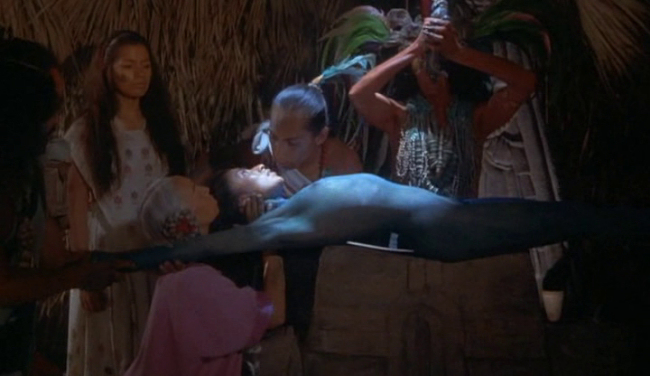
Who is queen of heaven? Astarte? Mary? Hera? Toci? Or would the queen by any name be that selfsame queen? 2000's The Other Conquest (La Otra Conquista) uses a blending of the Aztec Mother Goddess, Toci, with the Catholic Virgin Mary as a way into discussing missionary work under Hernan Cortes in the 1520s. A rather personal feeling film for the scope of its religious and historical subjects, it effectively captures the sense of confused Mexican identity in the early days of Spanish colonialism.
Mostly the story follows an Aztec scribe named Topiltzin (Damian Delgado) whom we meet painting a codex portraying the slaughter of his people, the aftermath of which we see before him.

He later joins a small group of survivors who decide to sacrifice a princess to the gods. They paint her body blue and a priest tears out her heart.

Towards the end of the ceremony, they're found by a captain serving under Cortes named Cristobal (Honorato Magaloni) and a friar named Diego (Jose Carlos Rodriguez). After a battle, they take the few surviving Aztecs captive and a stone idol to the Mother Goddess is replaced by a peculiarly lifelike idol of the Virgin Mary.

This was in the very early years of the Reformation and we can see here the worship of Mary the Protestants so objected to was in full swing. She has a baby in her arms, presumably Jesus, but no-one seems to pay much attention. The similarities between the Mother Goddess and the Virgin Mary are obviously apparent to Topiltzen but he finds Mary's signal somewhat muddier when he's whipped while being forced to look upon her compassionate face.

From Diego's point of view, the statue sheds a tear, revealing, I think, the filmmakers' beliefs. But the conflict is never resolved. Topiltzin seems to come to adore Mary but then at one point he spontaneously screams at the sky that Mary will always have his body but never his spirit. He's caught within some strange grey zone between paying lip service and genuine reverence, not unlike the self contradictory nature of a group who came to slaughter a populace before preaching a philosophy of love and compassion.

There is one really good performance in the film by Elpidia Carrillo as Cortes' Aztec mistress, and half sister of Topiltzin, Tecuichpo but otherwise the performances are fair and the camera work isn't particularly interesting. But the use of the goddess as a metaphor for conversation is intriguing and seems to touch on a deeper issue of men's disconnect from and worship of women.

No comments:
Post a Comment